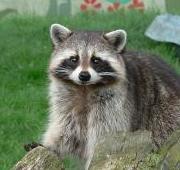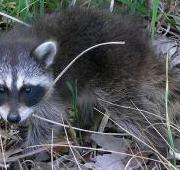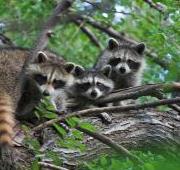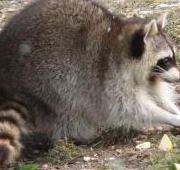 The raccoon is a medium sized bear-like mammal that was originally only found in North America. Due to the deliberate introduction of the raccoon into other countries, the common raccoon can also be found now in Europe and Japan.
The raccoon is a medium sized bear-like mammal that was originally only found in North America. Due to the deliberate introduction of the raccoon into other countries, the common raccoon can also be found now in Europe and Japan. The average raccoon is around 70 cm from the raccoons nose to the tip of the raccoons tail. A fully grown raccoon can weigh up to 10kg and can live for up to 20 years in captivity. Raccoons in the wild however, tend to have a much lower life expectancy.
The average raccoon is around 70 cm from the raccoons nose to the tip of the raccoons tail. A fully grown raccoon can weigh up to 10kg and can live for up to 20 years in captivity. Raccoons in the wild however, tend to have a much lower life expectancy.


The most distinctive feature of the raccoon is the black mask found around the eyes of the raccoon. The raccoon has a thick layer of fur which keeps it warm during the cold winters and raccoons also have extremely sensitive and and dexterous front paws with raccoons having been observed turning door knobs and opening jars.
Raccoons forage for their food and raccoons are often found close to water. Raccoons have been observed washing their food in water before consuming it! Although the reasons for this behaviour are not really known, it is thought that the sense of touch of the front paws of the raccoon is heightened when wet.
Their are around ten different species of raccoon that range in size but differ little in appearance, found throughout the Americas. The sense of touch is the most important for a raccoon and their agile front paws are covered in a spiny coating to protect them when they are not being used to aid eating.
Raccoons tend to mate in the late winter to early spring from January to March. However, more southernly raccoon species have been known to mate later with the mating season often lasting until June. After a gestation period of around 2 months, the female raccoon will give birth to roughly 5 baby raccoons, also known as kits or cubs.
The raccoon kits are born blind and deaf, with both senses appearing with the first month. Baby raccoons are not born hairless but instead have a layer of light coloured fur, with the distinctive black mask being visible from birth. Raccoon kits are normally about 10 cm long at birth and weigh around 75 g.
Raccoon Foot Facts
- Raccoons have four feet with five toes both their front hind feet which give the raccoon more stability when running and climbing.
- The underneath of the feet of the raccoon are bare-soled and flat which makes the raccoon waddle rather than walk.
- The front feet if the raccoon are similar to the hands of a human in both appearance and dexterity to allow to the raccoon to easily hold onto things.
- The larger back feet of the raccoon give the raccoon more power when running and balance when the front feet of the raccoon are in use.
- Raccoons have very nimble fingers on their front feet that enable them to untie knots, turn doorknobs and even open jars.
Raccoon Teeth Facts
- Raccoons have 40 teeth including four long and sharp canine teeth at the front of the mouth of the raccoon.
- Raccoons use their front hand-like feet to hold onto their food before using their teeth to chew it up and swallow it.
- The sharp canines in the front of the mouth of the raccoon are followed by the premolars which increase in size as they go into the mouth of the raccoon.
- The raccoon uses its molars and premolars to grind up and chewing their food until they are able to swallow it.
- Raccoons are known for their unique habit of washing their food when they are close to water, however raccoons will not pass up a tasty treat if there is no water around to wash it in.

